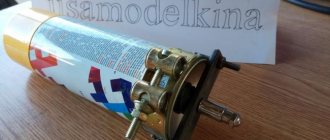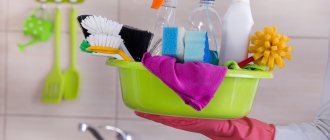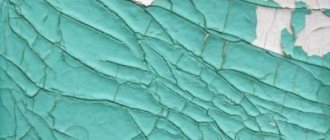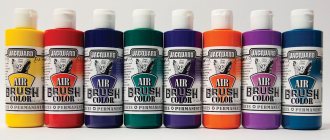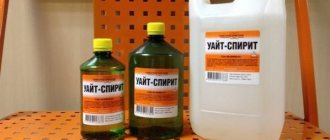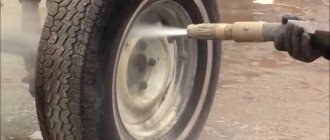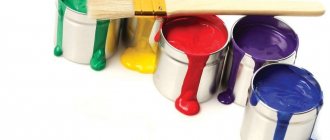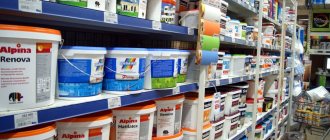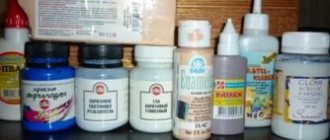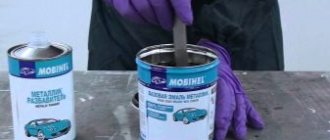Paints that are sold in aerosol cans are a rather unusual way to paint. They help make the coating even.
At the same time, the consumption of material by spraying is economical, and the markings on the packaging will help you decide on the shade.
You can fill such a container yourself. It is important to have markings and codes, especially when something needs to be partially repaired or repainted (for example, a car body).
But paint in cans is more expensive than in simple cans, and the variety of colors here is also not very large.
What then remains? You can make a shade of the desired color with your own hands and fill the existing spray can with it.
You can also use the services of professionals and then use the aerosol can for its intended purpose.
Advantages of aerosol application of dyes
Increased prices are the main disadvantage and difference between factory options and other analogues. Difficulties arise when choosing the right tones. In this case, it helps to independently pump paint into aerosol cans, the coloring of which was also carried out by the owner himself.
Sprayers in ready-made containers provide access to the following benefits for owners:
- Convenient storage and transportation;
- The container remains sealed, so you don’t have to worry about any problems;
- Even if there is some paint left in the can, you won’t need to use the excess right away;
- The original qualities of the materials in the container are preserved for a long time;
- The work is available even for beginners; there are no requirements for special skills;
- Easy painting in hard to reach places. At least because of this, refilling aerosol cans is not without meaning;
- Paint is applied to surfaces with defects to organize partial restoration;
- Different pressures on the can will help control the process;
- Quick preparation for use. There will be no need to wait for the paint to be thinned. It is enough to shake the container with your own hands so that the compositions inside are ready for further use;
- Saving. You don't have to worry about paint remaining on other surfaces or tools. Everything will go exactly where it is needed after filling the paint into the aerosol can.
Containers are used to store substances with different compositions, which differ in properties. It won’t be difficult to independently prepare exactly what is required for a specific situation.
The work is available even for beginners; there are no special skills requirements.
How to fill a spray can with your own hands - Metalist's Handbook
Paint guru➣Paints➣Working with paints➣
An interesting solution for coating is paints produced in spray cans. With their help you can evenly paint the surface.
Thanks to aerosol spraying, the consumption of paint and varnish material is not very large, and markings on the product help facilitate the selection of the required tone. You can even refill the paint into a spray can yourself.
The presence of marking codes is very important when, for example, a car body is partially repaired or restored.
But this factory-made form of production is much more expensive than conventional dyes, and it is not always possible to select the desired tone among the finished products.
What to do in this case? You can fill a spray can with the paint you purchased or tinted yourself, or you can turn to the services of specialists, and then enjoy all the benefits of fine spraying.
Advantages of aerosol application of dyes
The use of paints and varnishes produced in ready-made containers with a spray gun provides a number of advantages:
- Saving material. All the paint released from the can will fall directly onto the surface being painted, and will not remain on the roller, brush or other painting tool.
- Quick preparation for use. This paint does not need to be diluted before use and poured into a container for convenient use. It is enough to shake the dye container for 5 seconds so that the balls in it ensure mixing of the solution, and you can spray the coating onto the surface.
- Possibility of dosed use due to the difference in the force of pressing the sprayer. When painting small scratches and cracks, just lightly press the spray button.
- The ability to carry out partial restoration repairs by spraying a coloring composition onto damaged areas. With the right color scheme, after drying the surface will appear evenly painted.
- Even the most difficult to reach places can be easily painted.
- No special painting skills are required; even an amateur can handle the job.
- The remaining paint in the can does not require quick use; in such a container, it will retain its original qualities for a long time.
- Convenient for storage and transportation: the container is sealed, dyes will not spill out of it and will not stain the floor.
In such containers, dyes of various compositions and qualities are produced; they can be used on wood, metal, glass, and concrete; apply for external or internal work. Selecting the right color will not be difficult.
When is it necessary to fill the dye into the container?
This must be done in the following cases:
- tinted paint remains, and it must be preserved for a long time;
- color selection among finished aerosol products is impossible (for example, a complex color or such a dye simply does not exist).
You can pump paint into a spray bottle by contacting a specialized company, where they will quickly fill the required container using a vacuum unit. But such refilling is quite expensive, and if immediate use is intended, then you can pump the paint into the container yourself.
Diagram of a standard can
How to refill a cylinder yourself
Filling paint solutions into a spray can can easily be done with your own hands.
Of course, it will not provide such complete filling as with vacuum pumping with a special installation, but it is simple and cheap.
The cylinder can be used repeatedly.
Required tools:
- An empty can of deodorant or paint. If a container is used after dyes, then you need to fill in a solution of the same quality (for example, after acrylics - acrylic, after alkyds - alkyd). Incorrect selection of paint and varnish components can lead to a “chemical conflict” that will affect the quality of the coating.
- Paint for refilling. Any one will do - purchased in a store or tinted yourself with the necessary selection of shades.
- A large medical syringe without a needle: with its help the paint will be pumped into the container. To more effectively release the safety valve, you can put a broken needle on it.
- Bicycle nipple (can be cut from a worn-out inner tube).
- Pump (car or bicycle).
- Pressure gauge.
Operating procedure:
- Remove the cap and spray nozzle from the can.
- Draw the coloring solution into the syringe, insert it into the container until it stops, pressing the safety valve.
- Pour the dye into a container.
- Repeat the filling procedure until the container is approximately 2/3 full.
- If you used a deodorant container, you need to add 3-5 metal balls there. Balls from worn-out bicycle bearings are quite suitable for this purpose.
- The remainder of the container must be filled with pressurized air, otherwise the sprayer will not work. To do this, insert the bicycle nipple tightly, squeezing the safety balloon valve.
- Connect the pump to the nipple and, while pumping, create a pressure of up to 3-5 atmospheres. If you do less, you won’t get a full spray; if you do more, the container may not be able to withstand the load.
- After inflating, remove the nipple and replace the cap with the sprayer.
- Now you need to shake the can a little, stirring the coloring solution, and check its operation. For this purpose, release a small portion of the dispersed mixture onto an unnecessary board or other surface.
Source: https://ssk2121.com/kak-zapravit-krasku-v-ballonchik-svoimi-rukami/
When is it necessary to fill the dye into the container?
Typically, spray cans are used for leftover tinted paint that needs to be preserved for a long time. Or if it has become impossible to find a suitable shade among the finished products.
In specialized companies, the corresponding containers are filled using vacuum units. But this approach involves additional expenses. It’s easier to solve the problem yourself, figure out how to fill the cans with paint.
Typically, spray cans are used for leftover tinted paint that needs to be preserved for a long time.
Spray with two hands: it's faster and often better
Spray paints can be very time consuming to apply to large surfaces.
In addition, this can lead to surface unevenness. In warm and dry conditions, paint dries almost instantly, and even a small “oversplash” will flow onto nearby paint, which is already almost dry. When this happens, uneven surfaces are formed. Here is a method that will help you apply spray paints to the surface faster and get an even coating. Just hold one can in each hand! If one hand moves, the other will reflexively follow the same path. Remember that this method can lead to smudges on vertical surfaces. Make your approaches faster and practice on a piece of cardboard first.
Now you know how to most effectively apply aerosol paints to the surfaces of walls and products. Save time, effort and nerves!
Refilling methods
Most often, one method is chosen to solve the problem. Ready-made containers are used, but you can also choose a self-made option. It is allowed to use different methods for additional savings:
- Buying high-quality cans that hold the aerosol. And then change its design so that it is suitable for repeated use in practice. It doesn’t require a lot of work, the problem can be solved with minimal time;
- Purchase of special equipment for refueling. It also involves additional costs, but then easily pays for them due to its efficiency;
- You can contact workshops for wholesale orders. In this case, customers are given a discount. But refilling paint cans yourself is still cheaper.
It doesn’t require a lot of work, the problem can be solved with minimal time.
Proper use of spray paint cans
One can of paint is enough for 1 - 2 square meters. m. depending on volume.
Spray cans are easy to use by spraying a stream of paint onto any prepared surface.
The advantage of this type of painting is that it can be used for hard-to-reach places where a roller and brush are not entirely suitable and do not guarantee the quality of the work.
When applying paint, it is imperative to adhere to the temperature regime specified in the manufacturer's instructions, since the gas pressure in the cylinder depends on the temperature, which will significantly affect the quality of painting.
The temperature range when applying paint is from -10 to +30 degrees.
Take care of yourself!
It is necessary to work with paint in a ventilated area, wearing a painting respirator.
The surface to be painted must be clean and dry.
Before applying the aerosol, shake the can vigorously for 2 - 3 minutes and spray the paint at a distance of 25 - 30 cm. Periodic shaking while painting the surface will allow you to apply a colorful aerosol of the desired consistency.
How to create a craquelure effect (cracks in the paint layer)
Craquelure will give walls, furniture or doors a pattern of cobwebs or old cracked wood. To begin with, it’s a good idea to practice on a workpiece or a separate area.
This design is made using a special varnish - craquelure.
Materials for creating craquelure:
- acrylic paint in two colors (main and cracks)
- varnish - craquelure
- brush or sponge
- protective varnish
Paint the color of the cracks is applied to a dry surface in two layers to level it out.
When the paint has dried, spray or apply craquelure varnish with a sponge (brush) once or twice, depending on the thickness of the cracks or cobwebs.
For deeper and more pronounced cracks, the varnish is applied twice in a row, without allowing the first application to dry.
Then the varnish is allowed to dry and a layer of paint of a different color is applied. Impatient creative people often use a fan or hairdryer to dry things out.
To add chic, the cracks are covered with silver or gold powder.
A protective varnish is applied to the resulting pattern if necessary.
It is important to know that sometimes you will have to wait several days before the expected result appears. It depends on the humidity of the room and the technique for drying the pattern.
How to renew and protect a surface from corrosion using spray paint in a can
First, the surface is cleaned by removing rust and flaking paint.
Then it is moistened with a soap solution using a sponge and washed with clean water.
After the surface is completely dry, the can of anti-corrosion enamel is shaken for 3 minutes and sprayed in a thin layer.
Painting is repeated three or four times 15 - 20 minutes after the surface has dried.
How to repurpose an existing container
A hard bottom and the presence of a tube nozzle are the main conditions for converting an existing can into another one that can be used repeatedly. At home, it is impossible to refill paint under the same pressure as in factories. But this action opens up access to repeated refueling, for which you won’t have to pay as much.
From the devices you will need to select the following set:
- A pump from a car or bicycle that pumps up air;
- Pressure gauge. It is not necessary to take only new ones;
- Medical syringe, large enough;
- Nipple. As an option, it is cut from old bicycle inner tubes;
- An aerosol can that has already been used. Surely your family will find at least one of these.
It is quite enough to buy things that are easy to find in the garage cheaper on the regular market. The cap and sprayer must be removed from the can to begin filling. The syringe is filled with paint, then inserted into the container until it stops. At the same time, the safety valve must be released, otherwise it will not be possible to pump everything inside.
An acceptable option is to use containers left over from deodorant. Injection is carried out until 2/3 of the total volume is filled. Then a bicycle nipple is inserted and the can is filled with compressed air. Simply pouring paint inside will not work.
A hard bottom and the presence of a tube nozzle are the main conditions for converting an existing can into another one that can be used repeatedly.
Advantages and disadvantages of aerosols
There are no specific difficulties in the design of an aerosol can. Pressure paint is pumped inside in combination with a chemical gas to maintain balance between the components of the contents. The advantages of using aerosol enamel are undeniable, but there are also disadvantages.
The obvious advantages of aerosol enamels include:
- No preparation for painting, just a light shake of the can.
- The ability to paint areas with a complex configuration, with inconvenient small recesses or protrusions.
- No brushes, rollers or containers needed.
- Aerosol paint has the same performance characteristics as paint produced in various containers: its level of adhesion and elasticity meets all requirements, it is resistant to abrasion, sunlight, and moisture resistant.
- Short paint drying time.
- Convenient storage and transportation of cans.
- The sealing of the packaging not only prevents the paint from drying out, but also prevents the appearance of odor.
- The palette of shades satisfies the most demanding taste.
- The aerosol does an excellent job of updating cast iron and steel surfaces.
The list of shortcomings:
- No ability to mix colors from a spray can.
- You cannot change the thickness of the material using a solvent.
- It is necessary to first delimit the area to be painted with masking tape or other means to protect them from contact with the enamel as a result of spraying.
- The aerosol is inconvenient to use for outdoor work if the weather is windy.
- The relative fragility of painting, since when sprayed with an aerosol, the surface is covered with a thin layer.
- Without certain skills, it is difficult to achieve uniform coloring and avoid smudges and unsightly stripes.
Tips for choosing aerosols
A suitable aerosol paint should be selected taking into account several recommendations:
The total volume of paint in the aerosol must first be calculated, paying attention to the spray consumption rate indicated on the can, taking into account double or triple application of paint. The desired shade is selected from the catalog (RAL, NCS). The choice of aerosol enamel type depends on the material of the surface to be painted. Plastic, glass, wood are well painted with acrylic enamels
It is advisable to paint metal with zinc spray paint with an aluminum additive. An aerosol based on epoxy resin with the addition of pigments and fillers is suitable for ceramics or enameled surfaces. If the goal is not so much the coloring itself, but giving the surface a “new look,” you need to opt for enamel, which allows you to achieve various visual effects (fluorescent glow, display of some texture).
Paint selection
There are many hard-to-reach places that only spray paint can reach. The main thing is to decide which qualities are most interesting to the consumer in certain cases.
Experts give additional recommendations to those who are interested in the problem of choice:
- Heat-resistant paints are widely used indoors, where high levels of humidity are constantly maintained. Example – saunas and baths, bathrooms. Ordinary enamel begins to crack under such conditions;
- When processing stone structures, heat-resistant enamels will also become indispensable assistants;
- The same applies to the treatment of heating mains. The materials can even be applied over rust marks. An additional function of paint in this case is that it becomes insulation.
For each type of surface, certain materials are used. Acrylic paints are better suited for processing glass, wood, and plastic. Compositions with zinc and aluminum combine better with metal, and they are also easy to refill. For certain interiors, you can choose paints that have additional effects.
There are many hard-to-reach places that only spray paint can reach.
Preparation for application
Enamels in aerosols do not adhere well to contaminated substrates, so the product must be thoroughly cleaned. If possible, the surface is washed with soap to remove grease and then dried. Suitable cleaning agents may be used. Price tags and other pieces of paper should be scraped off with a knife.
If the surface is too smooth or polished, sandpaper can be used to improve adhesion. Rust is completely removed from metal parts using sandpaper, iron brushes, wine vinegar, and soda.
Painting should be done in a well-ventilated area with an exhaust hood; you can work outside with a humidity of no more than 65 - 70%, in sunny weather without strong wind. For street work, you must first cover the area with newspapers and press them down.
All areas that need to be protected from paint drops must be covered with paper tape or film. You must work in a respirator or mask. Have rags on hand to quickly wipe off paint marks.
Necessary conditions for refueling
It is better to contact a specialized company if you know for sure that the paint will not be used at the present time. If there is an urgent need for painting, the work can be done independently. The main thing is to select in advance the necessary components that will be refilled.
If there is an urgent need for painting, the work can be done independently.
Car paint for metal and chrome
There are several types:
- for painting an ordinary sheet of metal - the spectrum of action is quite wide;
- anti-ultraviolet - used in places that are often susceptible to the influence of ultraviolet radiation;
- temperature – suitable for surfaces that can withstand high temperatures (from 3000 C).
In addition, manufacturers offer varnishes for chrome-plated products (mirrors, handles, wheels).
It should be borne in mind that the paint cannot be called “long-lasting”. Over time, it loses its attractiveness, since it is just a simplified analogue of chrome plating. Therefore, it is used only to give an aesthetic appearance before sale or to touch up minor damage.
How to refill a cylinder yourself
The use of professional equipment ensures high quality work, but is not always affordable. Simple operation and accessibility are the main advantages of operations that are carried out in-house. Even if the filling volume of the container is not maximum. A specialized station can also provide services, but they are not always worth the price.
Before filling the can, you must carefully prepare the devices that have already been written about. The difference between the remaining actions is in strict sequence. Regardless of what filling composition is used.
- The syringe is filled with dyes.
- The needle on the syringe helps to press out the balloon fuse. The syringe is inserted into the container until it stops.
- Pumping paint into a can. The main thing is to choose the right composition. Usually the numbers on the packaging correspond to certain shades. RAL, Pantone, NCS are catalogs in which the choice of suitable materials is simplified. The desired shade can be easily obtained if necessary by mixing the base colors.
- Filling occurs until the material fills 2/3 of the total volume. For example, a cylinder with a volume of 520 is pumped into 400 ml. This figure is enough to paint 1.5 square meters. The condition is relevant when applying two layers of paint.
- Adding 5 balls inside the stirring container. You can use what's left over from bicycle bearings. The compressor is not used in this case.
Simple operation and accessibility are the main advantages of operations that are carried out in-house.
Holders for spray guns can be easily prepared at home to simplify work. The simplest option is from a sheet of plywood up to 10 mm thick. A square of 25 by 25 centimeters is cut out of it. A circle is cut out of it with a volume slightly smaller than that of the container itself used for paint. The gun is inserted inside a special groove sawn from the edge of the workpiece to the hole. The stand is installed on legs.
It can be very time consuming when applying spray paint to cans. With this technology, irregularities often appear on the surface. But you can avoid such negative consequences - to do this, it is enough to hold a spray can in each hand when painting, even if they are homemade. Approaches are made faster. It’s good if you have the opportunity to practice beforehand, this is an important condition.
Spraying paint in thin layers is the only reliable way to get rid of streaks on the surface. The previous coat must be completely dry before the next coat is applied. The main thing is to work out a strategy in advance, then getting the job done becomes easy. First, the material is used for all vertical surfaces. Then they move on to horizontal ones, before applying the next layer. With this approach, each surface will have enough time to dry.
Spraying paint in thin layers is the only reliable way to get rid of streaks on the surface.
Saving material and quality of finish are the main advantages when using compositions prepared independently. During operation, the balloon form of paint becomes one of the most convenient. Long-term preservation of original qualities is guaranteed under any conditions.
Application
With paint filled in this way you can:
- paint a decorative composition;
- evenly paint surfaces that have a complex configuration;
- carry out cosmetic or complete repair of a car body;
- draw graffiti on walls or airbrush a car;
- restore furniture and much more.
Self-filled dye, when creating the necessary pressure in the container, is evenly sprayed over the surface, ensuring material savings and quality of finishing.
The balloon form of release is convenient to use, ensures material savings and long-term preservation of the quality of residues unused during repair and decorative work.
Advantages and disadvantages
The advantages of this material include:
- Readiness. The product is always ready for use. The paint does not need to be diluted, prepared, poured into a special tray, or other similar work. All you need to do before work: shake the container a couple of times and start painting.
- Shipping. Paint can be transported in both large and small quantities without fear for the contents of the cans. A special device will prevent the substance from leaking. The container is completely airtight, preventing even the persistent and strong odor characteristic of paint from passing through.
- Convenience. The paint doesn't take up much space. It can be placed even in the most compact pantry. During operation, the cylinder is comfortable to hold in your hand. The elongated shape is practical and ergonomic. The material does not dry out during storage.
- Easy to use. No additional tools or equipment are needed. One can replaces a can of paint, a brush and a roller. This significantly saves material costs for repairs and time to complete them.
- Drying speed. The composition dries very quickly. The maximum time is from 5 to 6 hours.
Range
Not only the color of the composition differs, but also its texture after drying.
Careful painting. The substance in the can will help paint hard-to-reach places that cannot be reached with a roller or brush. In addition, the paint will lie evenly and neatly. A fine spray will reach any small and inconspicuous elements.
Price. The price for quality products is quite affordable. The average buyer has the opportunity to buy several cans at a time. This is quite enough to paint a standard room.
Originality. In finishing materials stores you will find products for unusual design. Connoisseurs of original decor will love pearlescent, fluorescent, shiny and other amazing paints.
Versatility. This type of paint can be used in different rooms of a residential building (bathroom, kitchen, bedroom, hallway and other rooms). This paint is also used by artists who paint in various techniques.
Aesthetics. Due to the uniform application of paint, the finished coating retains its attractive appearance for many years.
To the above properties, you can add several more advantages of paint: reliability, practicality, wear resistance, durability, resistance to moisture, frost, temperature and much more.
These characteristics may vary depending on the components in the composition, additional ingredients and the manufacturer.
Each product has a reverse side to the coin, and acrylic paint in cans is no exception. Let's take a look at the disadvantages in order to fully evaluate products of this type:
Graffiti as part of street art or vandalism
Graffiti has many directions. Some writers use spray paint to decorate dull gray walls and fences. They create original projects, real masterpieces. Such drawings can be seen in cities around the world. They are part of modern culture.
High-quality graffiti paint applies smoothly to various surfaces, dries quickly and retains its color for a long time. Hooligans take advantage of this quality. Adrenaline junkies claim that their inscriptions on walls, carriages, and facades of public buildings, created at night while running, are real graffiti art.
Quickly apply paint before no one notices and run away. To do this, they choose cans with a strong supply of nitro paint and a high pigment content. All over the world they are fighting against illegal wall painting. Such actions are classified as vandalism and hooliganism.
